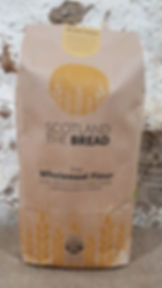Wheat & Flax - Growing food and fibre
- errin33
- May 24, 2022
- 4 min read

We recently planted two new crops at the Ecology centre. Although both have a long history in Scotland, this is our first adventure into wheat and flax!
Wheat - Soil to Slice
Faced with a patch of beautifully prepared soil (thanks to a group of hard-working volunteers!), we set about sowing the wheat grain in rows, known as drills. Each row was about 10cm apart and we planted the it about 4cm deep, to try and deter potential avian raiders! Sowing the grain in drills should also mean it will be easier to find and remove weeds from the newly emerging seedling rows.

The grain we planted was called Balcaskie landrace. This variety of wheat, and another of rye,have been developed by Scotland the Bread’, a collaborative project that aims to establish a Scottish flour and bread supply that is not only healthy and tasty, but also locally grown and sustainable. For more information about Scotland the bread visit here.
These days, most grain used for baking, brewing and distilling comes from only a small number of modern wheat varieties. Over the last 100 years, they have been selectively grown from a small number of varieties, to be highly productive when grown in intensive farming systems that use large amounts of artificial fertilisers, herbicides, fungicides and pesticides.

Not only are the crops genetically poor, meaning they are unable to adapt to a changing climate, but the agrochemicals needed to produce them are also contaminating out food, reducing biodiversity and contributing to climate change.
Scotland the Bread has researched heritage and evolutionary grain varieties and is growing them together to create a genetically diverse landrace. ‘Landrace’ crops are adaptable to local growing conditions, can grow in poorer soil conditions, and perform better under organic, regenerative farming practices. These traditional grains are also more nutritious than modern varieties and by growing and using local grain, we can reduce our food miles.

Through the‘Soil to Slice’ program,communities throughout Scotland can get involved with growing, harvesting, threshing, milling and baking with these traditional grains. As well as growing a patch of wheat this year, we are also using Scotland the Bread flour to make some of the tasty treats that you can find in our café.
Throughout the growing season we will be measuring and checking our wheat so that we can contribute citizen science data to Scotland the bread research. We are hoping that by harvest time we will have enough grain to make some ‘Ecology Centre flour’ (although, it will probably only make a very small loaf!)
Keep your eye on our social media channels to see how our wheat grows, or if you’d like to volunteer to help with our weeding or monitoring, get in touch at admin@theecologycentre.org.
Flax - Towards a Scottish Fibreshed
As well as growing plants for food to put in our bodies, we are also growing plants we can put on our body! Flax (Linum usitatisimum) was once widespread across Scotland and used to make one of Scotlands most important exports - linen. Flax has long fibres that are part of the stalk and these can be removed and processed into linen thread which is then woven into linen cloth.

Linen is one of the oldest textiles known to man. Fragments have been found in ancient Egyptian tomb, and some flax fibres have been estimated to be over 30,000 years old! Varieties of flax were, and indeed are, important not only for the production of fibres but also as a source of linseed and linseed oil, a good source of Omega-3 fatty acids. As a textile, linen became less popular as man-made fibres and mass-produced cotton became more readily available.

To turn flax into linen is a time-consuming process and requires multiple steps and possibly, a little bit of magic. The process involve setting, rippling, scutching, and hackling - all good Scrabble words and I’ll chat a bit more about each of these in a later blog post. Meanwhile, if you’re keen to find out more about the process, visit flaxland.co.uk.
Flaxland UK is based in Stroud and they have been leading the way in reviving Flax growing in the UK. They have shown us how to prepare and sow the flax seeds, and how to process the fibres once the flax is harvested. Flax takes about 90 days to grow and so at the Ecology Centre, it should be ready to pull up at about the same time as our wheat.
But why try and make linen? Well, as the social and environmental consequences of ‘fast fashion’ become ever more obvious, there is a need to develop more sustainable and equitable fibre systems. A growing movement called ‘fibreshed’ aims to reconnect consumers with knowledge about where and how their clothes are made. From implementing climate beneficial agriculture, regional manufacturing and education Fibreshed groups are coming together throughout the UK to raise the profile of regenerative and locally produced textiles. In Fife and across the East of Scotland, we are helping to establish our own Fibreshed, to encourage use of Scottish grown wool, flax and leather.
If you are interested in finding out more about the Fibreshed movement visit Fibershed.org. In Scotland, Ourlinenstories.com is keen to hear if you are growing a patch of flax, big or small, by using the #flaxscotland hashtag in your social media posts. You can find out more by visiting their website.

We’ll be posting updates on social media about how our flax, and our dye plant garden are developing over the next few months. If you are visiting the Ecology Centre in July, keep an eye out for the sea of blue flowers which should start to make a brief appearance in the mornings.
If you are interested in volunteering to help us grow or process our flax, please get in touch at admin@theecologycentre.org.
